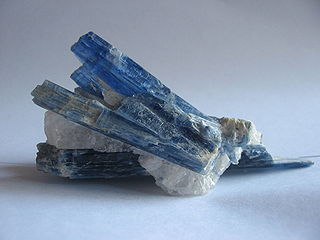
Kyanite is a typically blue aluminosilicate mineral, found in aluminium-rich metamorphic pegmatites and sedimentary rock. It is the high pressure polymorph of andalusite and sillimanite, and the presence of kyanite in metamorphic rocks generally indicates metamorphism deep in the Earth's crust. Kyanite is also known as disthene or cyanite.
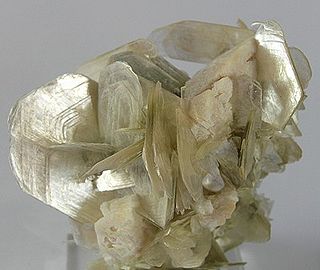
Muscovite (also known as common mica, isinglass, or potash mica) is a hydrated phyllosilicate mineral of aluminium and potassium with formula KAl2(AlSi3O10)(F,OH)2, or (KF)2(Al2O3)3(SiO2)6(H2O). It has a highly perfect basal cleavage yielding remarkably thin laminae (sheets) which are often highly elastic. Sheets of muscovite 5 meters × 3 meters (16.5 feet × 10 feet) have been found in Nellore, India.

Titanite, or sphene (from Ancient Greek σφηνώ (sphēnṓ) 'wedge'), is a calcium titanium nesosilicate mineral, CaTiSiO5. Trace impurities of iron and aluminium are typically present. Also commonly present are rare earth metals including cerium and yttrium; calcium may be partly replaced by thorium.

Prehnite is an inosilicate of calcium and aluminium with the formula: Ca2Al(AlSi3O10)(OH)2 with limited Fe3+ substitutes for aluminium in the structure. Prehnite crystallizes in the orthorhombic crystal system, and most often forms as stalactitic, botryoidal, reniform or globular aggregates, with only just the crests of small crystals showing any faces, which are almost always curved or composite. Very rarely will it form distinct, well-individualized crystals showing a square-like cross-section, including those found at the Jeffrey Mine in Asbestos, Quebec, Canada. Prehnite is brittle with an uneven fracture and a vitreous to pearly luster. Its hardness is 6.5, its specific gravity is 2.80–2.95 and its color varies from light green to yellow, but also colorless, blue, pink or white. In April 2000, rare orange prehnite was discovered in the Kalahari Manganese Fields, South Africa. Prehnite is mostly translucent, and rarely transparent.

Fluorite (also called fluorspar) is the mineral form of calcium fluoride, CaF2. It belongs to the halide minerals. It crystallizes in isometric cubic habit, although octahedral and more complex isometric forms are not uncommon.

Gibbsite, Al(OH)3, is one of the mineral forms of aluminium hydroxide. It is often designated as γ-Al(OH)3 (but sometimes as α-Al(OH)3). It is also sometimes called hydrargillite (or hydrargyllite).

Cryolite (Na3AlF6, sodium hexafluoroaluminate) is an uncommon mineral identified with the once-large deposit at Ivittuut on the west coast of Greenland, mined commercially until 1987.

Autunite (hydrated calcium uranyl phosphate), with formula Ca(UO2)2(PO4)2·10–12H2O, is a yellow-greenish fluorescent phosphate mineral with a hardness of 2–2+1⁄2. Autunite crystallizes in the orthorhombic system and often occurs as tabular square crystals, commonly in small crusts or in fan-like masses. Due to the moderate uranium content of 48.27% it is radioactive and also used as uranium ore. Autunite fluoresces bright green to lime green under UV light. The mineral is also called calco-uranite, but this name is rarely used and effectively outdated.
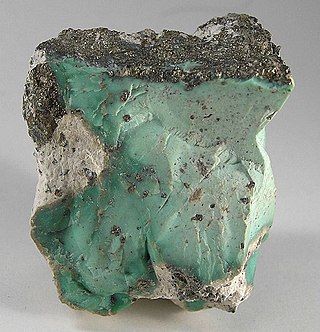
Variscite is a hydrated aluminium phosphate mineral (AlPO4·2H2O). It is a relatively rare phosphate mineral. It is sometimes confused with turquoise; however, variscite is usually greener in color. The green color results from the presence of small amounts of trivalent chromium (Cr3+
).
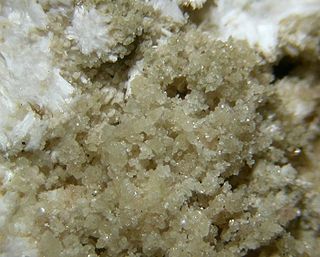
Boehmite or böhmite is an aluminium oxide hydroxide mineral, a component of the aluminium ore bauxite. It is dimorphous with diaspore. It crystallizes in the orthorhombic dipyramidal system and is typically massive in habit. It is white with tints of yellow, green, brown or red due to impurities. It has a vitreous to pearly luster, a Mohs hardness of 3 to 3.5 and a specific gravity of 3.00 to 3.07. It is colorless in thin section, optically biaxial positive with refractive indices of nα = 1.644 – 1.648, nβ = 1.654 – 1.657 and nγ = 1.661 – 1.668.

Alunite is a hydroxylated aluminium potassium sulfate mineral, formula KAl3(SO4)2(OH)6. It was first observed in the 15th century at Tolfa, near Rome, where it was mined for the manufacture of alum. First called aluminilite by J.C. Delamétherie in 1797, this name was contracted by François Beudant three decades later to alunite.

The chlorites are the group of phyllosilicate minerals common in low-grade metamorphic rocks and in altered igneous rocks. Greenschist, formed by metamorphism of basalt or other low-silica volcanic rock, typically contains significant amounts of chlorite.
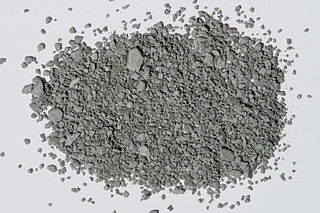
Illite, also called hydromica or hydromuscovite, is a group of closely related non-expanding clay minerals. Illite is a secondary mineral precipitate, and an example of a phyllosilicate, or layered alumino-silicate. Its structure is a 2:1 sandwich of silica tetrahedron (T) – alumina octahedron (O) – silica tetrahedron (T) layers. The space between this T-O-T sequence of layers is occupied by poorly hydrated potassium cations which are responsible for the absence of swelling. Structurally, illite is quite similar to muscovite with slightly more silicon, magnesium, iron, and water and slightly less tetrahedral aluminium and interlayer potassium. The chemical formula is given as (K,H3O)(Al,Mg,Fe)2(Si,Al)4O10[(OH)2·(H2O)], but there is considerable ion (isomorphic) substitution. It occurs as aggregates of small monoclinic grey to white crystals. Due to the small size, positive identification usually requires x-ray diffraction or SEM-EDS analysis. Illite occurs as an altered product of muscovite and feldspar in weathering and hydrothermal environments; it may be a component of sericite. It is common in sediments, soils, and argillaceous sedimentary rocks as well as in some low grade metamorphic rocks. The iron-rich member of the illite group, glauconite, in sediments can be differentiated by x-ray analysis.

Vauxite is a phosphate mineral with the chemical formula Fe2+Al2(PO4)2(OH)2·6(H2O). It belongs to the laueite – paravauxite group, paravauxite subgroup, although Mindat puts it as a member of the vantasselite Al4(PO4)3(OH)3·9H2O group. There is no similarity in structure between vauxite and paravauxite Fe2+Al2(PO4)2(OH)2·8H2O or metavauxite Fe3+Al2(PO4)2(OH)2·8H2O, even though they are closely similar chemically and all minerals occur together as secondary minerals. Vauxite was named in 1922 for George Vaux Junior (1863–1927), an American attorney and mineral collector.
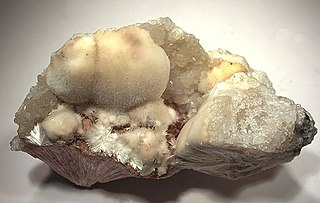
Xonotlite, or eakleite, is a mineral of general formula Ca6Si6O17(OH)2 named by the German mineralogist Karl Friedrich August Rammelsberg in 1866. The name originates from its discovery locality, Tetela de Xonotla, Puebla, Mexico. Although it was discovered in 1866, it was first described in 1959. It is approved by the IMA, but it is a grandfathered species, meaning the name supposedly represents a valid species til this day.

Zeunerite is a green copper uranium arsenate mineral with formula Cu(UO2)2(AsO4)2·(10-16)H2O. It is a member of the autunite group. The associated mineral metazeunerite is a dehydration product of zeunerite.

Lemanskiite is a mineral that was first discovered in a mine at Abundancia mine, El Guanaco mining district, Chile, with the ideal formula of NaCaCu5(AsO4)4Cl·3H2O. Originally, this mineral was discovered as being dimorphus with lavendulan, but in 2018 it was revised to only have 3 water molecules. Lemanskiite typically occurs as rosette-shaped aggregates of thin lamellar or needle-shaped aggregates, such as lammerite. Lemanskiite is dark sky blue with a light blue streak, it is brittle with an excellent cleavage plane. It was found on a dumping site in the abandoned Abundancia mine, El Guanaco mining district, Region II, Antofagasta Province, Chile The new mineral has been named after Chester S. Lemanski, Jr. This mineral and name were then approved by the Commission on New Minerals and Mineral Names of the International Mineralogical Association.

Ganophyllite is a phyllosilicate mineral. It was named by Axel Hamberg in 1890 from the Greek words for leaf (φύλλον) and luster (γανωμα); the latter one was chosen due to the lustrous cleavages. The mineral was approved by the IMA in 1959, and it is a grandfathered mineral, meaning its name is still believed to refer to an existing species until this day. Tamaite is the calcium analogue, while eggletonite is the natrium analogue of said mineral.
Hendricksite is a member of the trioctahedral micas group. The mineral was named by Clifford Frondel and Jun Ito in honor of Sterling Brown Hendricks, who studied micas. It was approved in 1966 by the IMA.
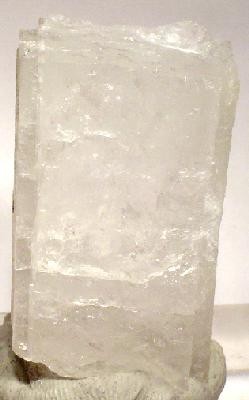
Chiolite is a tetragonal-ditetragonal dipyramidal mineral, composed of sodium, fluorine, and aluminium. The name originates from the combination of the Greek words for snow (χιώυ) and stone (λίθος). It is an allusion to its similarity and appearance to cryolite. Chiolite is an IMA approved mineral that has been grandfathered, meaning the name chiolite is believed to refer to a valid species to this day. Synonyms of chiolite are arksudite, arksutite, chodneffite, chodnewite and nipholith. It was first discovered in the Ilmen mountains, Russia, in 1846. Chiolite has been a valid species from the same year of its discovery.



















